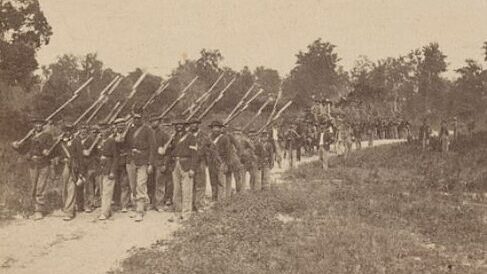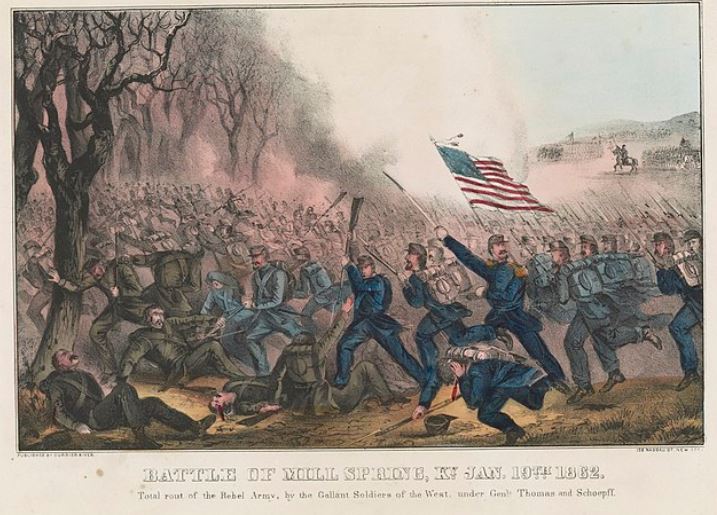During the American Civil War, Kentucky found itself standing at a crossroads of loyalties.
The state of Kentucky occupied a unique position during the American Civil War. With pro-Union and pro-Confederate factions vying for control, Kentucky attempted to remain neutral at the outset of the conflict.
However, both the Union and Confederacy recognized the state’s strategic importance and sought to draw Kentucky to their side.
In this article, we examine what side Kentucky was on in the Civil War and how this question shaped its role in the conflict
1. Kentucky’s Divided Loyalties
Kentucky’s loyalties were sharply divided heading into the Civil War.
19.5% of Kentucky’s 1860 population were slaves. Many Kentuckians saw nothing wrong with this slave institution. The state also had close economic ties to the South via the Mississippi River.
However, the ancestors of many Kentuckians hailed from Northern states, and the state boasted top educational institutions like Transylvania University that aligned culturally with the North.
Politically, Kentucky produced renowned leaders like Henry Clay and Abraham Lincoln who favored the Union. But others like John C. Breckinridge sympathized with the South’s rights and the doctrine of states’ rights.
When war broke out in 1861, Kentucky Governor Beriah Magoffin sympathized with the south but ultimately favored neutrality, rejecting Lincoln’s call for troops. He believed Kentucky should mediate between the warring sides, not take up arms.

However, Kentucky’s initial neutrality stance reflected its inner conflict. Though remaining in the Union, Kentucky’s complex mix of identities and allegiances meant it was truly a border state caught between North and South.
2. Confederate Invasion and Union Support
Despite neutrality, both sides positioned themselves just outside Kentucky for eventual invasion.
The Commonwealth’s fragile neutrality was shattered when Confederate General Leonidas Polk violated Kentucky borders by capturing Columbus in September 1861.

Though Polk hoped this invasion would sway Kentucky sentiment toward the Confederacy, it largely backfired. In response, the Kentucky legislature petitioned Union troops for assistance.
Kentuckians viewed Polk’s actions as unwarranted aggression against a neutral state.
With Confederate forces now occupying parts of the state, Unionist sympathies hardened.
In November 1861, Kentucky elected a decisively pro-Union legislature and approved a new governor, James Robinson, who aligned with the North.
After a failed attempt to negotiate a Confederate withdrawal, Kentucky officially sided with the Union. The legislature approved Union recruiting and welcomed federal troops into the state.
Though Kentucky didn’t secede and remained in the Union, Confederates retained a presence within the state throughout 1861-62.

The Commonwealth became a borderland ravaged by raids, guerrilla actions, and pitched battles for control. But despite Kentucky’s early neutrality, the Confederate invasion ultimately tipped the state toward the Union cause.
3. Kentucky and its Strategic Importance in the Civil War
Beyond its complex identity, Kentucky’s geographical significance placed it squarely at the center of the Civil War’s strategic map.
Imagine it as a gateway, its northern border formed by the mighty Ohio River, serving as a natural barrier for the Confederacy.

Controlling Kentucky meant controlling this gateway, opening a path for Union forces to penetrate the South’s heartland.
The state’s network of navigable rivers like the Tennessee and Cumberland further amplified its importance, acting as vital transportation arteries for troops and supplies.
This strategic value wasn’t lost on either side.
- For the Union, losing Kentucky would expose Ohio, Indiana, and Illinois to Confederate attacks.
- For the Confederacy, gaining Kentucky meant securing a crucial defensive line and a springboard for offensive operations into the North.
In September 1861, the Kentucky legislature reluctantly sided with the Union, a choice with lasting consequences.
Joining the Union secured the crucial Ohio River border, denying the Confederacy a vital invasion route. Kentucky’s resources also proved invaluable.
Its fertile lands provided critical food supplies for Union troops, its coal fueled war industries, and its manpower bolstered the Union army with over 100,000 soldiers, including nearly 25,000 Black Kentuckians who fought for emancipation.
However, Kentucky’s decision didn’t guarantee peace within its borders.

Confederate sympathizers formed guerilla units, leading to brutal guerilla warfare that ravaged the state.
Despite this internal conflict, Kentucky’s strategic alignment with the Union proved immensely influential. It prevented a Confederate invasion of the North, secured vital resources, and bolstered the Union army, all contributing significantly to the eventual Union victory.
4. Military Conflict in Kentucky
The Civil War played out across Kentucky’s soil in numerous battles, reflecting the state’s internal divisions. The strategic importance in its territory lead to bloody clashes throughout the war.
Led by Braxton Bragg, Confederate forces entered Kentucky hoping to sway its allegiance and secure vital resources. Though achieving tactical victories like Perryville, they ultimately failed to capture strategic cities and withdrew, marking a pivotal Union success.
Let’s explore some key battles that etched their marks on Kentucky’s landscape and history:

Battle of Mill Springs (January 19, 1862): This early Union victory under George H. Thomas dealt a critical blow to Confederate aspirations in eastern Kentucky. It solidified Union control of the vital Cumberland Gap, a gateway to the South.

Battle of Perryville (October 8, 1862): The largest and bloodiest Civil War battle in Kentucky. While tactically a Confederate victory under Braxton Bragg, their failure to capture strategic crossroads marked it as a strategic Union victory, ultimately forcing the Confederates to abandon their Kentucky campaign.
Battle of Chickamauga (September 19–20, 1863): Though primarily fought in Georgia, this key Confederate victory involved thousands of Kentuckians on both sides. It temporarily halted Union advances in the South but showcased the continued presence of Kentucky soldiers in the conflict.

Battle of Stones River (December 31, 1862 – January 3, 1863): This was one of the bloodiest battles of the Civil War. This bloody stalemate near Murfreesboro, Tennessee, involved significant Kentucky participation. Although inconclusive, it marked the end of Confederate hopes for a decisive victory in Tennessee and Kentucky.
Battle of Cynthiana (June 11–12, 1864): A surprise Confederate raid led by John Hunt Morgan resulted in the capture of a Union garrison, highlighting the ongoing guerilla warfare that plagued Kentucky throughout the war.
5. Kentucky’s Dual Governments
While many states during the Civil War chose a clear side, Kentucky’s story takes a complex turn with the existence of two competing governments: the pro-Union state government in Frankfort and the Confederate government-in-exile established at Russellville.
This unique situation, deeply rooted in the state’s divided loyalties, created an internal conflict that mirrored the national struggle and inflicted hardships on its citizens.
The pro-Union government, led by Governor Beriah Magoffin (later James F. Robinson and Thomas E. Bramlette), faced an uphill battle.
Although officially aligned with the Union, Magoffin himself harbored Confederate sympathies, reflecting the state’s internal divisions. This created confusion and hampered Union war efforts. Despite these challenges, the pro-Union government ultimately managed to maintain control of Frankfort and secure federal support.
Meanwhile, the Confederate government-in-exile, operating with limited resources and legitimacy, attempted to govern from Russellville.
Led by Governor George W. Johnson and later Richard Hawes, it struggled to gain widespread support or control significant territory. However, its existence fueled guerrilla warfare and further divided Kentuckians, forcing neighbors and families to choose sides.
The impact of this dual government structure was far-reaching:
- Internal struggles: Kentuckians faced difficult choices, torn between family ties, economic realities, and political beliefs. Brother fought against brother, neighbor spied on neighbor, and communities fractured along ideological lines.
- Guerilla warfare: The presence of a rival government and Confederate sympathizers within the state fueled rampant guerilla warfare. Raids, sabotage, and civilian casualties became a grim reality for many Kentuckians.
- Economic hardship: The war disrupted trade and agriculture. Shortages of supplies, inflation, and destruction of infrastructure added to the suffering of Kentucky’s citizens.
- Political instability: The legitimacy and authority of both governments were constantly contested, creating a chaotic and uncertain political climate within the state.
6. Slavery in Kentucky
While classified as a slave state, Kentucky’s relationship with slavery differed significantly from the Deep South. Its enslaved population, around 20% compared to an average of 40% in Deep South states, primarily served in small farming operations and urban households.
This smaller-scale system fostered closer relationships between enslaved people and their owners, leading to a wider spectrum of views on slavery within Kentucky society.
Landowners held diverse opinions. Some, particularly in the east, believed slavery to be economically inefficient and morally questionable. Others, especially in the west, viewed it as essential to their agricultural practices and social order.
Non-slaveholding whites also presented varied perspectives. Many small farmers opposed slavery due to competition for land and labor. Others, motivated by racism or economic dependence, supported the institution.
Enslaved people, despite enduring oppression, actively resisted their bondage through escapes, rebellions, and cultural expressions. They also contributed significantly to the state’s economy and cultural fabric.
Kentucky’s path to emancipation reflected these complexities. Kentucky initially declared neutrality, seeking to avoid the conflict. However, internal pressure and Union military presence swayed the state towards gradual emancipation. In 1863, a new constitution began freeing enslaved children born after that date, with full emancipation set for 1865. However, the state remained formally pro-slavery until the ratification of the 13th Amendment in 1865.
While undeniably a slave state, its smaller scale and diverse population fostered a range of viewpoints that differed from the Deep South.
7. Final Thoughts: Kentucky Caught in the Crossfire
Kentucky’s Civil War journey defied simple categorization.
Despite being a slave state, internal divisions – ranging from economic interests to moral stances – prevented a clear allegiance to the Confederacy.
Confederate attempts to force their hand only pushed them further towards the Union.
This unique position, as a strategic border state coveted by both sides, resulted in a complex dance of neutrality, invasion, and eventual alliance with the Union.
Further Reading
If you enjoyed this article, you may be interested to read more about the American Civil War events, or perhaps read about the bloodiest battles of the Civil War or the South’s important victories. Read here for more general American history.







